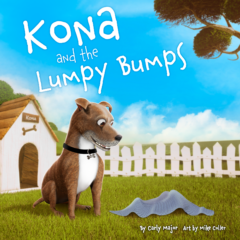THE BAREFOOT LIBRARIAN BOOK AWARD 2024 Winner

THE BAREFOOT LIBRARIAN BOOK AWARD 2024
Sponsored by Reader Views
Kona and the Lumpy Bumps
Written by Carly Major
Illustrated by Michael Coller
Published by Lolly Books (2024)
ISBN: 979-8989884605
Kona and the Lumpy Bumps is a fun, funny, and engaging rhyming story about an endearing dog with several interesting characteristics, some common in dogs but some not so much. Like countless dogs, he loves rolling in the grass and does not like baths. He will chew on shoes no matter how smelly they are and dig through trash when no one is around. However, unlike many dogs, Kona doesn’t mind laying on sharp rocks in the garden or sitting on a pinecone. But like a lot of humans, Kona has a seemingly inexplicable anxiety – he refuses to sleep on his blanket if it has a bump, fold, or wrinkle.
Kona’s dog mom tries to figure out the cause of his anxiety. Does Kona see prickles or bugs? Is he scared he will get scratches? Or maybe he just needs some hugs. Perhaps his tummy gets “…nauseous, all squiggly and queasy?” Does he feel uneasy? There seems to be no apparent reason that Kona gets anxious about his blanket not being just so. However, the story explains that Kona should not feel bad about how he likes his blanket because that is just part of his unique personality. And it goes on to say readers should not judge Kona or try to change him. Instead, they should accept and embrace him just as he is, quirks and all.
The cheerful, kid-friendly illustrations add so much to the story. Kona is irresistibly adorable. Since picture books have so few words, illustrations are often used to provide more details. The illustrator makes excellent use of this opportunity, creating images that keep the readers smiling and giggling as they turn the pages.
Picture books are valuable tools in effectively teaching children essential social-emotional lessons. In the picture book Kona and the Lumpy Bumps, the author successfully uses humor and a charming dog to deliver her message about patience, acceptance, and kindness. A canine character is especially effective here because dogs are easy to relate to and usually have a calming effect, creating a safe space for readers to be more receptive to the author’s message. In addition, addressing the sensitive topic of anxiety from an animal perspective prevents children from feeling singled out, targeted, or uncomfortable.
The author wrote this book to share what she has learned from Kona, her real-life dog, and her three daughters, who experienced anxiety and other challenges: “…that children deserve to be heard, be accepted, and should be supported in their unique struggles.” At the end of the book, she shares some questions to provide a springboard for deeper discussions of the book’s themes. This book is recommended for teaching children to understand anxiety in themselves and others.
Eve Panzer
The Barefoot Librarian
